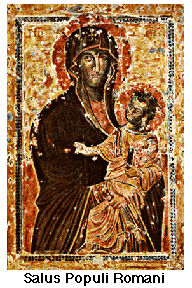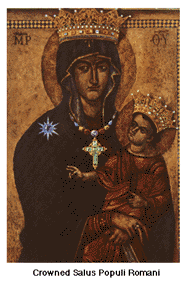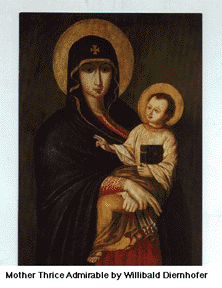Salus Populi Romani
Salus Populi Romani
Protectress of the Roman People (also translated: Health of the Roman People)
— M. Jean Frisk

The miraculous image, Protectress of the Roman People, is perhaps the best loved and honored Marian icon in Rome, Italy. It is located in the Cappella Paolina of Saint Mary Major Basilica in Rome, known to English-speaking pilgrims as Lady Chapel. The church, Saint Mary Major, is considered the third of the Roman patriarchal basilicas. The church and its Marian shrine are under the special patronage of the popes.
Some authorities claim the Salus Populi Romani image can be traced to the post-iconoclastic period of the eighth century. Others indicate that the image, as we know it today is not found earlier than the thirteenth century. At latest by the fifteenth century, it was honored as a miraculous image, and from that time on it was considered an image particularly honored and subsequently used by the Jesuits to foster devotion to the Mother of God.
The name given to this type of Marian image in iconography is "Hodegetria," a word meaning "Guide of the Way." The word, "Hodegetria" -- as applied here -- originates from the monastery grounds of the "guides," the "Hodegon," in Constantinople. It is thought that an image of this type was once located in a chapel there.
As one notes on the icon, Jesus rests on the left arm of Our Lady, his right arm slightly raised in blessing. In his left hand he holds a book; he appears to be looking up at his mother; Mary's gaze looks out to the people. Most Hodegetria images depict Mary's right hand pointing to Christ. In the Salus Populi Romani, Mary's right hand crosses over her left in a gentle embrace of the child. Mary is depicted as the woman who looks to the people, drawing them with her gaze to center on her divine son. Her son, Jesus, rests lightly, almost weightlessly on her arm. He blesses the people she looks at, he looks at her, his mother, as one of them, but particularly as the one who shared most intimately in his Incarnation.
The image is five feet high by three and a quarter feet wide. It is painted on a thick cedar slab. Mary wears a gold-trimmed dark blue mantle over a red tunic.
Origin:
The Roman Breviary states, "After the Council of Ephesus (431) in which the Mother of Jesus was acclaimed as Mother of God, Pope Sixtus III erected at Rome on the Esquiline Hill, a basilica dedicated to the honor of the holy Mother of God. It was afterward called Saint Mary Major and it is the oldest church in the West dedicated to the honor of the Blessed Virgin Mary." The Roman Pontifical gives an additional account, "The Liberian basilica, today called Saint Mary Major, was founded by Pope Liberius (352-366) and was restored and enlarged by Sixtus III. ... Pope Liberius selected a venerated picture that hung in the pontifical oratory. It had allegedly been brought to Rome by St. Helena."
Salus Populi Romani is one of the so-called "Luke images." There are many throughout the world which are attributed to Saint Luke. The origin of "Luke images" is unknown, but a charming legend has prevailed through the ages. It reveals that after the Crucifixion, when Our Lady moved to the home of St. John, she took with her a few personal belongings – among which was a table built by the Redeemer in the workshop of St. Joseph. When pious virgins of Jerusalem prevailed upon St. Luke to paint a portrait of the Mother of God, it was the top of this table that was used to memorialize her image. While applying his brush and paints, St. Luke listened carefully as the Mother of Jesus spoke of the life of her son, facts which the Evangelist later recorded in his Gospel.
Legend also tells us that the painting remained in and around Jerusalem until it was discovered by St. Helena in the fourth century. Together with other sacred relics, the painting was transported to Constantinople where her son, Emperor Constantine the Great, erected a church for its enthronement." (Joan Carroll Cruz, Miraculous Images of Our Lady, 1993, p. 137f.)
Contrary to the above, and as stated earlier, this particular image itself cannot be traced earlier than the thirteenth century, latest fifteenth, when it was generally honored as miraculous and subsequently considered the Jesuit Madonna.
Miraculous Character
What makes this particular image miraculous?
The answer is found in the mysterious origins that lie shrouded in history, the fact that it has endured, and the many miraculous stories of protection that are attributed to Our Lady imaged therein. Cruz mentions the following:
During the pontificate of St. Gregory the Great (590-604) a plague viciously attacked the people of Rome, killing entire families. The pontiff fervently prayed to the Blessed Mother. During the Easter festivals he carried her image in solemn procession. Arriving at Hadrian's Mausoleum (now called San Angelo), an angelic choir was heard singing the joyful Resurrection hymn:
Regina coeli, laetare, alleluia;
Quia quem meruisti portare, alleluia;
Resurrexit sicut dixit, alleluia.
Without hesitation, the holy Pontiff added:
Ora pro nobis Deum, alleluia.
[Queen of Heaven, rejoice, alleluia; for he whom you did merit to bear, alleluia; has risen as he said, alleluia; pray for us to God, alleluia.]
After the Pontiff spoke these words there appeared above Hadrian's Mausoleum an angel, believed to be St. Michael, who replaced in his scabbard the sword of vengeance which he had held over the city.
Devotion


Popes of the past and present expressed their devotedness to Mary in front of the image; A. Rum reminds us that "Paul VI prayed [at Saint Mary Major] to the Madonna whom he had that day proclaimed Mother of the Church. 'With a spirit full of trust and filial love,' he said, 'we raise our glance to you, despite our unworthiness and our weakness. You who have given us Jesus, the source of grace, will not fail to help your Church, at this time when she is flowering because of the abundance of the gifts of the Holy Spirit and is committing herself with renewed zeal to her mission of salvation." (Dictionary of Mary, pp. 303-4)
Signs of papal interest are the following coronations:
Clement VIII (1592-1605) Gregory XVI (August 15, 1838) Pius XII (November 1, 1954: Marian Year for the centenary of the dogmatic definition of the Immaculate Conception)
These papal coronations honor Mary for her share in Christ's Incarnation and saving work. The Marian coronation signifies recognition of Mary's heavenly victory, that is, her holiness. In Roman Catholic liturgy there is a rite entitled, The Rite for Crowning an Image of the Blessed Virgin Mary. The rite, promulgated by the Church on March 25, 1981, shows Mary's queenship rooted in the Paschal Mystery and a queenship based on love and service of Christ and his Church.
Others who were specially devoted to Our Lady, Protectress of the Roman People, are St. Stanislaus Kostka; St. Ignatius Loyola, founder of the Jesuits, who celebrated his first Mass here on Christmas night in 1538; and St. Francis of Borgia, third general of the Jesuits, who was the first to petition the pope for permission to reproduce the image for the Jesuit houses of study.
With the permission to duplicate the icon, the Jesuits had an effective pastoral method to foster love for the church through love for Our Lady. As part of their plan for church renewal from the grassroots in post-Reformation times, the sodalities were formed. These were, in the first place, organizations within seminaries which fostered the spiritual life through imitation of Marian faith and reliance on her formative power. The sodality program later spread beyond seminary walls. An example of this devotion is found at Ingolstadt, Germany. In the Bavarian seminary there, the image became known as the Mater-admirabilis, later, the Mater ter admirabilis, the Mother Thrice Admirable. A whole spirituality developed from the theological implications of Mary as Mother of God, Mother of the Redeemer, and Mother of the Redeemed.
The devotedness to Mary through the Salus Populi Romani image became an assist, even if one of secondary importance, to the Jesuit movement.
Of further interest is what is to be noted about "copying" an image. The Roman image and the Ingoldstadt image can be compared here. (See pictures above.) One notes the similiarity, but also the slight nuances that make the "copy" unique to each place.
Another example is its spread to China, where it was known as the Madonna of Singanfu. An exact sixteenth-century Chinese copy is located in the Chicago Field Museum of National History.
It is also interesting that an image such as this may undergo title changes. Due to the legend of the establishment of Saint Mary Major as a miracle of snow falling in August, the image is also called Our Lady of the Snow or Our Lady of Snows.
Here in the United States, it is the Oblate Fathers who established a National Shrine of Our Lady of Snows in Belleville, Illinois in 1958. The desire to relate to the ancient tradition of the first Marian shrine of the Roman church had a part to play in selecting the name. The image is not the same, but the link nevertheless remains.
Meditation
Mary, Mother of God, it is our Christian belief that all who fashion their lives in imitation of your son, Jesus Christ, and have placed their hope in him are gathered together in a communion of saints. Those who have gone before us live in intimate communion with Christ. You are the most eminent of them, for you were drawn into his life and being as no other. You who gave him human life followed Jesus, the Way, the Truth and the Life.
Mary, look at us. Look at all who are centered on your son. At the present time some of his disciples are pilgrims on earth. Others have died and are being purified, while still others are in glory, contemplating 'in full light, God himself triune and one, exactly as he is ' (Lumen Gentium, 49; See: Catechism of the Catholic Church (CCC), #954). All of God's people hunger to be intimately one with him.
All of us, however, in varying degrees and in different ways share in the same charity towards God and our neighbors, and we all sing the one hymn of glory to our God. All, indeed, who are of Christ and who have his Spirit form one Church and in Christ cleave together. (Lumen Gentium 49; cf. Ephesians 4:16) ... So it is that the union of the wayfarers with the brethren who sleep in the peace of Christ is in no way interrupted, but on the contrary, according to the constant faith of the Church, this union is reinforced by an exchange of spiritual goods. (Lumen Gentium 49; See: CCC) #955.
Mary, we are the wayfarers and we hunger for this exchange of spiritual goods with you who were so intimately close to Jesus Christ. Your image, as protectress of the Roman people, reminds us that you invite us to center on Christ. Your arms embrace Jesus fully, effortlessly. Jesus, whose burden is light and yoke is easy, wishes to be as close to every individual as he is to you. You are both wayfarer and guide to us wayfarers on our pilgrimage of faith.
Teach us, Mary, to embrace Christ fully, to make him our way, our truth, our life. Teach us, Mary, to carry Christ to the world, and, each in our own way, to give him birth in the hearts of many. Protect your people, Mary; protect your Church. These are his people, the people of the Way.
All About Mary includes a variety of content, much of which reflects the expertise, interpretations and opinions of the individual authors and not necessarily of the Marian Library or the University of Dayton. Please share feedback or suggestions with marianlibrary@udayton.edu.
